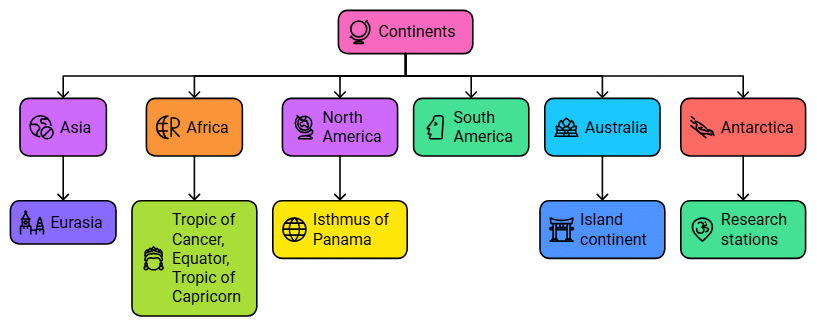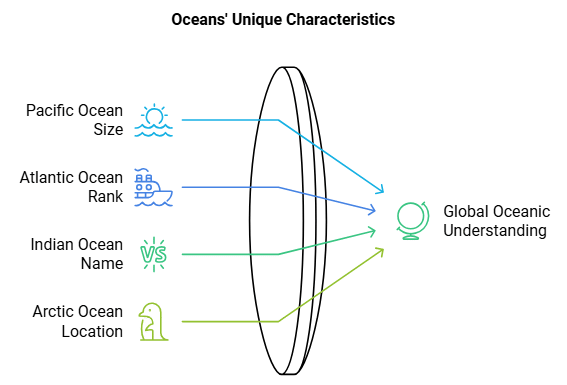Class 6 Geography Chapter 5 Notes - Major Domains of the Earth

There are three main components of the environment – Lithosphere, Atmosphere and Hydrosphere.
- The solid portion of the Earth on which we live is called the Lithosphere.
- The gaseous layer that surrounds the Earth is the Atmosphere.
- The area covered by water is called Hydrosphere.
- The zone which contains all forms of life is called Biosphere.
Lithosphere
- It comprises the rocks of the earth’s crust and the thin layers of soil.
- There are two main divisions of the earth’s surface.
- The large landmasses are known as the continents.
- The huge water bodies are called the ocean basins.

Continents
- There are seven major continents.
- The greater part of the land mass lies in the Northern Hemisphere.
- Asia is the largest continent.
- The combined landmass of Europe and Asia is called Eurasia.
- Africa is the second largest continent. It is the only continent through which the Tropic of Cancer, the Equator and the Tropic of Capricorn pass.
- North America is the third largest continent of the world.
- South America and North America are linked by a very narrow strip of land called the Isthmus of Panama.
- Australia is the smallest continent. It is also called an island continent.
- Antarctica is permanently covered with thick ice sheets. ,India has a research station named as Maitri and Dakshin Gangotri at Antarctica. .
Hydrosphere
- More than 71 % per cent of the Earth is covered with water, therefore, the Earth is called the blue planet.
- More than 97% of the Earth’s water is found in the oceans.

Oceans
- The four major oceans are the Pacific Ocean, the Atlantic Ocean, the Indian Ocean and the Arctic Ocean.
- The Pacific Ocean is the largest ocean.
- The Atlantic Ocean is the second largest ocean.
- The Indian Ocean is the only ocean named after a country, that is, India.
- The Arctic Ocean is located within the Arctic Circle.
Atmosphere
- The atmosphere protects us from the harmful effects of the sun’s rays.
- The atmosphere extends up to a height of about 1,600 kilometres.
- The atmosphere is divided into five layers—the troposphere, the stratosphere, the mesosphere, the thermosphere and the exosphere.
- The atmosphere is composed mainly of nitrogen and oxygen.
Biosphere – The Domain of Life
- The biosphere is the narrow zone of contact between the land, water and air.
- All the living organisms including humans are linked to each other and to the biosphere for survival.
- The organisms in the biosphere may broadly be divided into the plant kingdom and the animal kingdom.
- Increase in the amount of C02 leads to an increase in global temperature. This is termed as global warming.
The earth is the only planet where human beings find three life sustaining elements—land, water and air. The surface of the earth is a complex zone. Here three main components of the environment—lithosphere, atmosphere and hydrosphere meet, overlap and interact.
- The lithosphere refers to the solid portion of the earth where we live.
- The atmosphere refers to the gaseous layers which surrounding the earth.
- The hydrosphere refers to the water bodies that exist on the earth’s surface.
- The biosphere is the narrow zone where we find land, water and air together. Life exists here.
- The earth’s surface is divided into continents and ocean basins.
- Continents are large landmasses of the earth while ocean basins are huge water bodies.
- Mount Everest is the highest mountain peak. Its height is 8,848 metres above the sea level.
- The greatest depth of 11,022 metres is recorded at Mariana Trench in the Pacific Ocean.
- There are seven continents—Asia, Europe, Africa, North America, South America, Australia and Antarctica.
- Asia is the largest continent while Australia is the smallest continent.
- Antarctica is permanently covered with thick ice sheets. Hence, it is not suitable for human settlement.
- More than 71% of the earth is covered with water and 29% is with land.
- More than 97% of the earth’s water is found in the oceans. Ocean water is salty. It is of no human use. A large proportion of the rest of the water is in the form of ice sheets and glaciers or under the ground. Only 0.03% of water is available as fresh water which is usable by human beings.
There are four major oceans—the Pacific Ocean, the Atlantic Ocean, the Indian Ocean and the Arctic Ocean in order of their size.
- The Indian Ocean is the only ocean named after a country, i.e. India.
- The atmosphere is divided into five layers. These layer starting from earth’s surfaceare—the troposphere, the stratosphere, the mesosphere, the thermosphere and the exosphere.
- The atmosphere is composed of several gases—Nitrogen (78%), Oxygen (21%), other gases like carbondioxide, argon and others comprise 1%.
Oxygen is essential for our life. We can not live without it. Nitrogen is essential for the growth of living organisms. Carbon dioxide absorbs heat radiated by the earth and in this way it keeps the earth warm. It is also essential for plants.
- The biosphere is the zone where life exists. From tiny microbes and bacteria to huge mammals are found in the biosphere. There is a close link between all these organisms including humans.
- The organisms in the biosphere are divided into plant kingdom and the animal kingdom.
- The three domains of the earth interact with each other and affect each other. For example emission from industries pollute the air.
Increase in the amount of CO2 leads to an increase in global temperatures which is known as global warming.
Lithosphere: The solid portion of the earth on which we live is termed as the lithosphere.
Atmosphere: The gaseous layers that surround the earth is known as the atmosphere.
Hydrosphere: The water bodies on the earth’s surface is known as hydrosphere.
Biosphere: It is the narrow zone where land, water and air together are found. All forms of life exists here.
Continents: The large landmasses are called continents.
Ocean basins: The huge water bodies are called the ocean basins.
Strait: It is a narrow passage of water connecting two large water bodies like seas and oceans.
Isthmus: It is a narrow strip of land joining two landmasses.
Plant Kingdom: The part of biosphere consisting of plants and trees.
Animal Kingdom: The part of biosphere consisting of an animal.
Global warming: Increase in the amount of carbon dioxide leads to an increase in the global temperatures. This is known as global warming.
|
44 videos|128 docs|19 tests
|
FAQs on Class 6 Geography Chapter 5 Notes - Major Domains of the Earth
| 1. What are the major domains of the Earth? |  |
| 2. How do the lithosphere, hydrosphere, atmosphere, and biosphere interact with each other? |  |
| 3. What is the significance of the hydrosphere in the Earth's system? |  |
| 4. How does human activity impact the major domains of the Earth? |  |
| 5. Why is it important to study the major domains of the Earth? |  |





















